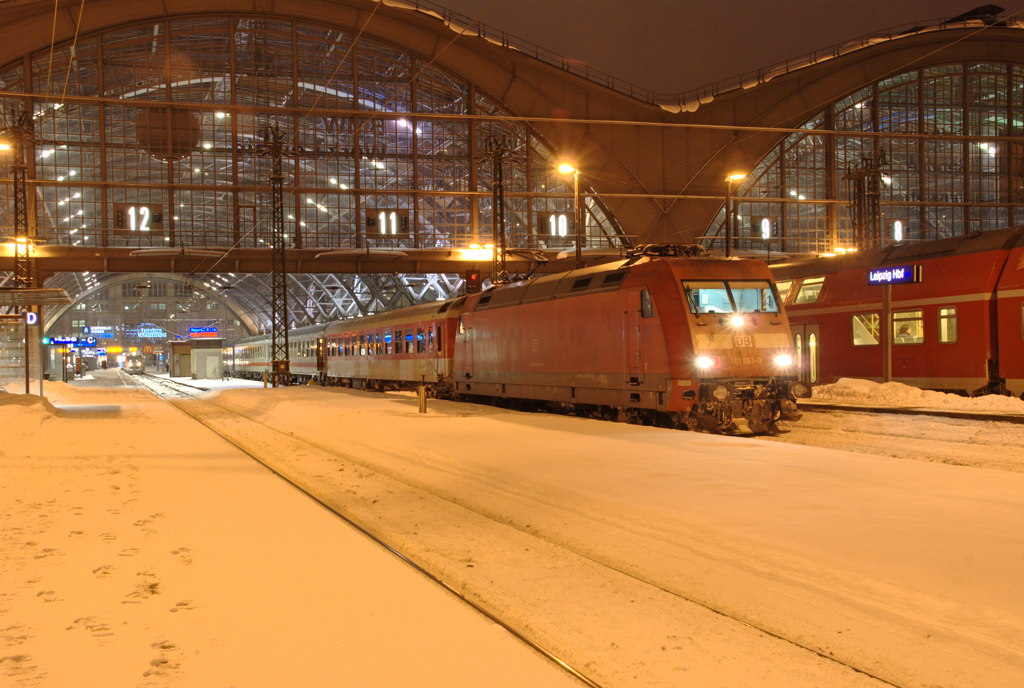Sleeping in my train / I will possess you...
A slight variation of a line from that Roxette song just came to my mind when I was thinking about a suitable title for this post... ![]() I left the house past nine last night in order to try and capture the "Canopus" sleeper train – also known as CNL 458 – which runs from Prague Central to Zurich Central Station, calling at Dresden, Leipzig, Erfurt, Frankfurt, Mannheim, Heidelberg, Karlsruhe and Basel, and a couple of additional stops in between. The "CNL" designation is spelt out as "CityNightLine", I should add.
I left the house past nine last night in order to try and capture the "Canopus" sleeper train – also known as CNL 458 – which runs from Prague Central to Zurich Central Station, calling at Dresden, Leipzig, Erfurt, Frankfurt, Mannheim, Heidelberg, Karlsruhe and Basel, and a couple of additional stops in between. The "CNL" designation is spelt out as "CityNightLine", I should add.
The train's composition is a bit complex, actually: From Prague to Dresden, the train runs as EN 456 – "EN" meaning EuroNight – with four coaches. Then, three coaches, designated as train D 61458, are added for the bit to Erfurt, where said coaches are removed again, while eleven other coaches are coupled up, having come from Berlin as CNL 1258. The three foremost coaches then are open from Fulda to Basel, where they are again uncoupled.
For unknown reasons, the train was about 35 minutes late, but in my opinion was worth the additional waiting ![]() .
.

At Leipzig, 101 061 took over the train for the biggest section of its trip to Basel. I certainly did not envy the poor guy of a shunter who had to do the coupling in the bitter cold of the night!
As is the case in many parts of the city, the track field of Leipzig Central is largely illuminated with sodium lamps, which gave the entire scene a glow of warmth which of course was not really there.
The train had been brought to Leipzig by the following loco, the image of which really does not do it the justice it deserves – but given the time of day and resulting lighting conditions, I had little choice but to do a "hovercraft" photo from the platform, which I normally try to avoid...

This is a Czech class 371 dual system locomotive, equipped for 3 kV DC and 15 kV AC. While it does look a bit old, the class actually was created in the late 1980s only, by the Škoda Works at Pilsen. This type, which was delivered from 1991 onwards, was built for both the Deutsche Reichsbahn, which continued to exist till 1994, and the former Czechoslovakian railways – the DR designation for it having been class 230, and the original Czechoslovakian one class 372. However, the Czechs eventually had six of these 120 kph locos rebuilt for a 160 kph top speed, which were then redesignated as class 371. The type also remained in the DB inventory as class 180, with a total of 20 locos having been built, while the Czechs had fifteen. The class has a 3,260 kW power output, initial tractive effort of 280 kN, and weigh in at 84 tonnes. In Germany, this type was given the nickname of "Knödelpresse", literally translated as "Dumpling Press" – as a nod to its origins.

The braking gear information is written out on a metal plaque – the smaller one above it being the Škoda logo. From top to bottom: Service weight of 84 tonnes, braking weights: P+E160 176 tonnes, P+E 130 tonnes, P 107 tonnes, G 38 tonnes, handbrake 2x 8 tonnes. The braking gear comprises a DAKO brake valve with settings G and P. The encircled "K" indicates that the loco is fitted with composite brake shoes.

The 371s are now wearing TSI-formatted running numbers as well – the first four letters of course being references to country of origin and operator ("ČD" meaning "České Dráhy", "Czech Railways"), 91 being an indication for this being an electric loco, and 54 being a country code for the Czech Republic.



4 Comments
Recommended Comments
Create an account or sign in to comment
You need to be a member in order to leave a comment
Create an account
Sign up for a new account in our community. It's easy!
Register a new accountSign in
Already have an account? Sign in here.
Sign In Now